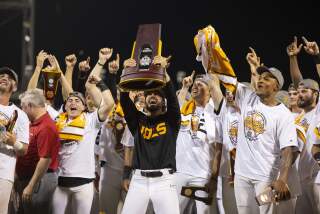Homespun Omaha Proves an Ideal Host
- Share via
OMAHA — George Horton and a few Cal State Fullerton teammates did not know what awaited when they ventured from their hotel on their first night here in 1975.
The Titans were in town for their first appearance in the College World Series, and the boys from Southern California hungered for whatever night life the city offered. As they huddled on the street, they asked a passerby for directions to a bus stop and the nearest entertainment.
“The guy stopped, gave us a few names of places and then he just said, ‘Here, take my car, have a good time and meet me back here around 11,’ ” said Horton, now Fullerton’s coach. “He threw us the keys and off we went, cruising through town thanks to this local’s generosity. That was my introduction to the way things are in Omaha during the World Series.”
Players, coaches and the fans who pack Rosenblatt Stadium in record numbers each year say it has been that way since 1950, when after a two-year trial run in Kalamazoo, Mich., and a one-year stopover in Wichita, Kan., the College World Series found a home. Midwestern hospitality and homespun values are hallmarks of an event that has made this city synonymous with college baseball. No other NCAA championship event comes close in terms of longevity at one location.
“The goal of every Division I baseball team at the start of the season is the same,” said USC Coach Mike Gillespie, who played for the Trojans’ national championship team in 1961, guided his club to the 1998 title and has his team back for the third time in four years. “No one says, ‘We want to make it to the World Series.’ Everyone says, ‘Let’s go to Omaha.’ ”
What began as a two-team, two-day matchup has grown into an eight-team, 10-day showcase that is televised live nationally on ESPN and CBS. Fans from across the country migrate to Omaha regardless of the teams involved. Last year, the average daily attendance for nine sessions was 22,324.
“People who really don’t go out and watch any other games or sporting events wouldn’t miss a World Series game,” said Steve Pivovar, a sportswriter for the Omaha World-Herald who grew up in Omaha and has covered the series since 1981. “It’s almost a civic duty.”
The chamber of commerce for this city of 390,000 encourages citizens and businesses to “Buy the Big O.” And they do when it comes to the College World Series.
More than two dozen local businesses sponsor the event. Eight local service clubs adopt the teams while they are in Omaha, transporting them to various events and assisting any way they can.
“The Omaha community has nurtured this from the time it arrived and has made it part of the fabric of the community,” said Jack Diesing Jr., chairman and president of the nonprofit College World Series of Omaha Inc. “It’s like someone said to me the other day, ‘The NCAA basketball Final Four is like going to Las Vegas. Going to the World Series is kind of like going to Disneyland.’ ”
Tim McNeil, deputy director of the Douglas County Convention and Visitors Bureau, estimates that about 4,500 fans in attendance each day are from out of town. A study by a Creighton University economics professor last year determined the event has an annual economic impact of $26.7 million.
“Other cities have signature events that are one day, two days or long weekends,” McNeil said. “This is 10 days of constant ringing of the cash registers.”
As the tournament’s format has expanded over the years, the crowds inside Rosenblatt Stadium have grown. There is a 400-person waiting list to buy reserved field-box and loge-level seats despite the fact that only two teams from Nebraska--hometown Creighton in 1991 and Nebraska this year--have made World Series appearances.
The Cornhuskers’ presence has predictably ratcheted up interest and intensity. On Thursday, fans waited in a line 300 yards long for the chance to purchase 1,000 available seats for opening games today and Saturday and the championship game June 16. Though scalping is illegal, championship game tickets were reportedly fetching as much as $300 apiece.
As they have been every year, about 12,000 ticket books that include 10 general admission tickets to be used for any game were originally sold for $30. On Thursday, they were going for $60--with no guarantee of admission. The tickets, for about 5,000 available bleacher seats, are honored on a first-come, first-served basis. That means a potential 120,000 ticket holders could show up today for the Cornhuskers’ opener against Cal State Fullerton, which will be preceded by a game between Stanford and Tulane with an expected appearance by President Bush.
“It’s been absolutely crazy,” said Rita Bower, the World Series ticket manager for 32 years.
It took many years to reach this level of madness.
Clint Evans, the baseball coach at California, conceived the idea of staging a national championship series after a 1946 college all-star game went over well at Fenway Park in Boston. Cal beat Yale--and a first baseman named George Bush--in the first college championship series in 1947 at Hyames Field on the campus of Western Michigan in Kalamazoo.
A year later, USC and Yale played for the title after winning four-team double-elimination playoffs. USC won the best-of-three series in three games for the first of its record 12 championships.
In 1949, the championship series was expanded to four teams and moved to Wichita, the host site of the successful National Baseball Congress semipro tournament. Texas won the first of two consecutive titles by defeating Wake Forest.
Omaha offered to host the event in 1950 and the American Assn. of College Baseball Coaches agreed with hopes of greater promotion and, perhaps, permanence.
Diesing’s father, Jack Diesing Sr., who took over organization of the event in 1963, once said that the World Series lost money in nine of its first 13 years in Omaha.
“And the four years that they made money, they gave it away to charity so they wouldn’t have to pay income tax,” he said. “They were always broke.”
The World Series turned the corner financially in 1964 and has been run as a successful nonprofit since 1967. Next year, all-time attendance will surpass 5 million, a milestone former Omaha World-Herald sports editor Floyd Olds predicted when, on the day of the stadium’s opening in 1948, he wrote: “In the years to come, the structure will provide wholesome entertainment for thousands--yes, in time, even millions.”
The stadium, home to the Kansas City Royals’ triple-A affiliate, has undergone about $19 million in improvements in the last decade. An enclosed stadium club with a restaurant and lounge along the right-field line, a state-of-the-art press box and media facility and a large video screen in the outfield are among the amenities.
Over the years, there have been whispers that the NCAA has been approached with--and was listening to--offers from other cities with larger stadiums. But Omaha is in the first year of a new 10-year contract that includes an automatic rollover every five years.
Jack Diesing Jr. intends to keep it that way.
“I think we have a way of treating people as if they are part of the family--not strangers,” he said. “So when they leave here, they go, ‘Wow. Those people really care about us.’ ”
More to Read
Go beyond the scoreboard
Get the latest on L.A.'s teams in the daily Sports Report newsletter.
You may occasionally receive promotional content from the Los Angeles Times.











